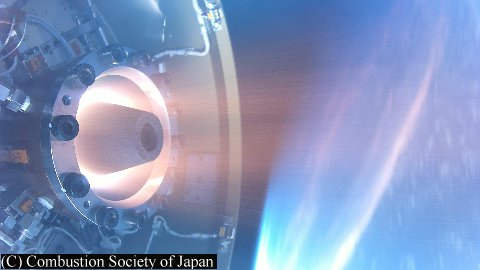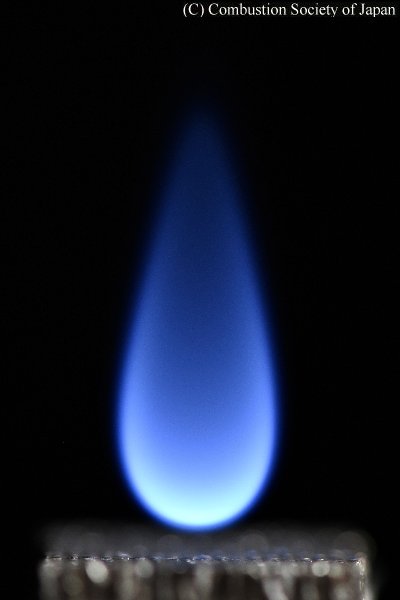Photo Contest
2021 Photo Contest -Beautiful Flames- The HIGHEST AWARD

World First! Detonation Engine Space Demonstration
Jiro KASAHARA1, Koichi MATSUYAMA1, Ken MATSUOKA1, Akira KAWASAKI1, Hiroaki WATANABE1, Noboru ITOUYAMA1, Keisuke GOTO1, Kazuki ISHIHARA1, Valentin BUYAKOFU1, Tomoyuki NODA1, Akiko MATSUO2, Ikkoh FUNAKI3, Hiroto HABU3, Shinsuke TAKEUCHI3, Satoshi ARAKAWA3, Junichi MASUDA3, Kenzi MAEHARA3, Kazuhiko YAMADA3, Tatsuro NAKAO3, Shuichi NAKAMURA4, Shinji TOYONAGA4, Osamu HARADA4, Hidefumi KAWANO4, Fumitaka YAMAMOTO4, Syouji KAWAMOTO4, Kazuyuki HIGASHINO4, Daisuke NAKATA5, Masaharu UCHIUMI5, Naoya MITA6, Hiromi JINDO6, Ichiro DOYAMA6, Tatsuya KATO6, Sounding Rocket S-520-31 Experiment Team
1 Nagoya University
2 Keio University
3 JAXA/ISAS
4 NETS Corporation
5 Muroran Institute of Technology
6 MEIJI ELECTRIC INDUSTRIES
Explanation
On July 27th, 2021, the world's first space flight demonstration of the Detonation Engine System (DES) was successfully performed using the JAXA sounding rocket S-520-31. The photo shows the moment of operation of the rotating detonation engine (RDE) in space. The elliptical chemiluminescence on the left side of the photo is combustion caused by methane-oxygen detonation, and a supersonic-speed jet is fanning out under vacuum to the right side of the photo. The right side of the photo is the Earth taken from space. This photo data was recovered on the ocean by the re-entry capsule RATS, which has a deployable aeroshell.
2021 Photo Contest -Beautiful Flames- The MERIT AWARD

Teardrop of Flame
Shinji NAKAYA1, Koichi OMI1, Takaaki WATANABE1, Mitsuhiro TSUE1
1 The University of Tokyo
Explanation
This picture is a flame taken from the rich side of the triple flame formed in a uniform flow on the burner consisting of a rich methane/air mixture, air, and nitrogen slots. It was designed to generate a triple flame with a height of several centimeters in order to meet the restrictions and requirements of the experimental equipment regarding the flow rate and calorific value. A micro Nikkor lens with a 2x teleconverter was used to take a close-up shot. A lot of trials and errors for the designs and the prototype productions were required to make a small triple flame. After all, we had designed and produced a prototype burner successfully, which satisfied all requirements and restrictions. Therefore, this flame is a drop of grace for us or a tear of hardship.
Shooting equipment: NIKON AF-S MICRO NIKKOR 105mm 1: 2.8G ED, AF-S TELECONVERTER
TC-20EIII, NIKON D850 ISO 100, F10, 20 seconds
2021 Photo Contest -Beautiful Flames- The MERIT AWARD

Blooming flame
Masaharu NAKAJIMA1, Noritaka SAKO1, Jun HAYASHI1, Himeko YAMAMOTO2, Satoshi UKAI2, Yu DAIMON2, Hiroshi KAWANABE1
1 Kyoto University
2 Japan Aerospace Exploration Agency
Explanation
Flames in the photograph are diffusion flames formed where air is supplied through a cylindrical sintered metal and methane is supplied through a surrounding slit. The cylindrical sintered metal has 20 mm in height and 12.5 mm in diameter. The flame shown in photographs has a double flame structure of an inner inverse diffusion flame and an outer diffusion flame of methane/air. Four photographs were formed by changing the flow rates of air and methane. From left to right, the air flow rates were 3.5 L/min, 12.0 L/min, 22.0 L/min, and 30.0 L/min, and the methane flow rates were 1.7 L/min, 3.0 L/min, 5.5 L/min, and 4.5 L/min, respectively. The flames in the photographs looks as if a flower bud gradually swelling and blossoming.